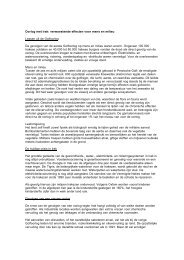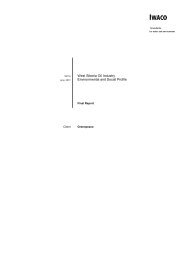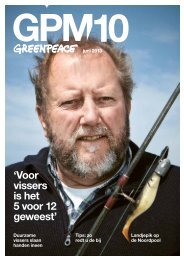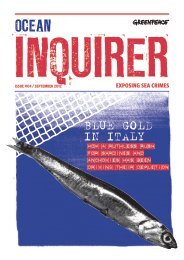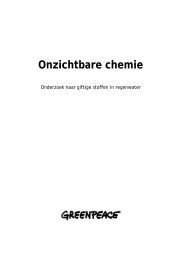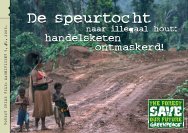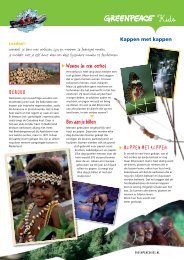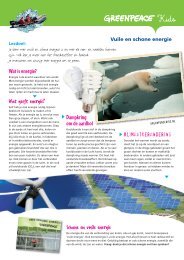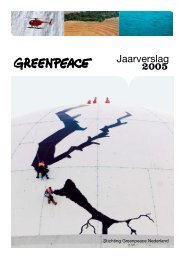man-made chemicals in human blood. levels of - Greenpeace ...
man-made chemicals in human blood. levels of - Greenpeace ...
man-made chemicals in human blood. levels of - Greenpeace ...
Create successful ePaper yourself
Turn your PDF publications into a flip-book with our unique Google optimized e-Paper software.
References.<br />
1. Patand<strong>in</strong> S, Weisglas-Kuperus N, De Ridder MA, Koop<strong>man</strong>-Esseboom C, Van Staveren WA, Van der Paauw<br />
CG, Sauer PJJ. Plasma polychlor<strong>in</strong>ated biphenyl <strong>levels</strong> <strong>in</strong> Dutch preschool children either breast-fed or<br />
formula-fed dur<strong>in</strong>g <strong>in</strong>fancy. Am J Public Health 1997; 87: 1711-4.<br />
2. Committee on the Implications <strong>of</strong> Diox<strong>in</strong> <strong>in</strong> the Food Supply, Food and Nutrition Board. Diox<strong>in</strong>s and diox<strong>in</strong>like<br />
compounds <strong>in</strong> the food supply. Strategies to decrease exposure. National Academy <strong>of</strong> Sciences, 2003.<br />
3. Patand<strong>in</strong> S, Dagnelie PC, Mulder PG, Op de Coul E, Van der Veen JE, Weisglas-Kuperus N, Sauer PJJ.<br />
Dietary exposure to polychlor<strong>in</strong>ated biphenyls and diox<strong>in</strong>s from <strong>in</strong>fancy until adulthood: a comparison<br />
between breast-feed<strong>in</strong>g, toddler, and long-term exposure. Environ Health Perspect 1999; 107: 45-51.<br />
4. Angerer J, Kafferle<strong>in</strong> HU. Gas chromoatography method us<strong>in</strong>g electron-capture detection for the<br />
determ<strong>in</strong>ation <strong>of</strong> musk xylene <strong>in</strong> hu<strong>man</strong> <strong>blood</strong> samples. Biological monitor<strong>in</strong>g <strong>of</strong> the general population. J<br />
Chromatogr B Biomed Sci Appl 1997; 693: 71-8.<br />
5. Ross PS, De Swart RL, Van der Vliet H, Willemsen L, De Klerk A, Van Amerongen G, Groen J, Brouwer A,<br />
Schipholt I, Morse DC, Van Loveren H, Osterhaus AD, Vos JG. Impaired cellular immune response <strong>in</strong> rats<br />
exposed per<strong>in</strong>atally to Baltic Sea herr<strong>in</strong>g oil or 2,3,7,8-TCDD. Arch Toxicol 1997; 71: 563-74.<br />
6. Legler J, Brouwer A. Are brom<strong>in</strong>ated flame retardants endocr<strong>in</strong>e disruptors? Environ Int 2003; 29: 879-85.<br />
7. T<strong>of</strong>t G, Guillette LR Jr. Decreased sperm count and sexual behavior <strong>in</strong> mosquito fish exposed to water from a<br />
pesticide-contam<strong>in</strong>ated lake. Ecotoxicol Environ Saf 2005; 60: 15-20.<br />
8. Feeley M, Brouwer A. Health risks to <strong>in</strong>fants from exposure to PCBs, PCDDs and PCDFs. Food Addit<br />
Contam 2000; 17: 325-33.<br />
9. Patand<strong>in</strong> S, Koop<strong>man</strong>-Esseboom C, De Ridder MA, Weisglas-Kuperus N, Sauer PJJ. Effects <strong>of</strong><br />
environmental exposure to polychlor<strong>in</strong>ated biphenyls and diox<strong>in</strong>s on birth size and growth <strong>in</strong> Dutch children.<br />
Pediatr Res 1998; 44: 538-45.<br />
10. Jacobson JL, Jacobson SW. Evidence for PCBs as neurodevelopmental toxicants <strong>in</strong> hu<strong>man</strong>s. Neurotoxicology<br />
1997; 18: 415-24.<br />
11. Questionnaire for nutrition assessment, University <strong>of</strong> Wagen<strong>in</strong>gen, The Netherlands.<br />
12. Sjod<strong>in</strong> A, Hagmar L, Klasson-Wehler E, Kronholm-Diab K, Jacobsons E, Berg<strong>man</strong> A. Flame retardant<br />
exposure: polybrom<strong>in</strong>ated diphenyl ethers <strong>in</strong> <strong>blood</strong> from Swedish workers. Environ Health Perspect 1999;<br />
107: 643-8.<br />
13. Birnbaum LS, Staskal DF. Brom<strong>in</strong>ated flame retardants: cause for concern? Environ Health Perspect 2004;<br />
112: 9-17.<br />
14. Kafferle<strong>in</strong> HU, Angerer J. Trends <strong>in</strong> the musk xylene concentrations <strong>in</strong> plasma samples from the general<br />
population from 1992/1993 to 1998 and the relevance <strong>of</strong> dermal uptake. Int Arch Occup Environ Health 2001;<br />
74: 470-476.<br />
15. Bauer K, Fröbi C. Blutkonzentrationren von polycyclischen und nitromoschusverb<strong>in</strong>d<strong>in</strong>gen bei deutschen<br />
Probanden. Umweltmediz<strong>in</strong>ische Praxis 1999; 12: 235-7.<br />
16. Schreurs RHMM, Legler J, Artola-Garicano E, S<strong>in</strong>nige TL, Lanser PH, Se<strong>in</strong>en W, Van der Burg B. In vitro<br />
and <strong>in</strong> vivo anti-estrogenic effects <strong>of</strong> polycyclic musks <strong>in</strong> zebra fish. J Environ Sci Technol 2004; 38, 6.<br />
17. T<strong>of</strong>t G, Edwards TM, Baatrup E. Guillette LJ Jr. Disturbed sexual characteristics <strong>in</strong> male mosquito fish<br />
(Gambusia holbrooki) from a lake contam<strong>in</strong>ated with endocr<strong>in</strong>e disruptors. Environ Health Perspect 2003;<br />
111: 695-701.<br />
18. Fisher JS. Environmental anti-androgens and male reproductive health: focus on phtalates and testicular<br />
dysgenesis syndrome. Reproduction 2004; 127: 305-315.<br />
19. Skakkebaek NE, Rajpert-De Meyts E, Ma<strong>in</strong> KM. Testicular dysgenesis syndrome: an <strong>in</strong>creas<strong>in</strong>gly common<br />
developmental disorder with environmental aspects. Hu<strong>man</strong> Reproduction 2001; 16: 972-978.<br />
20. Colon I, Caro D, Bourdony CJ, Rosario O. Identification <strong>of</strong> phtalate esters <strong>in</strong> the serum <strong>of</strong> young Puerto Rican<br />
girls with premature breast development. Environ Health Perspect 2000; 108: 895-900.<br />
11



